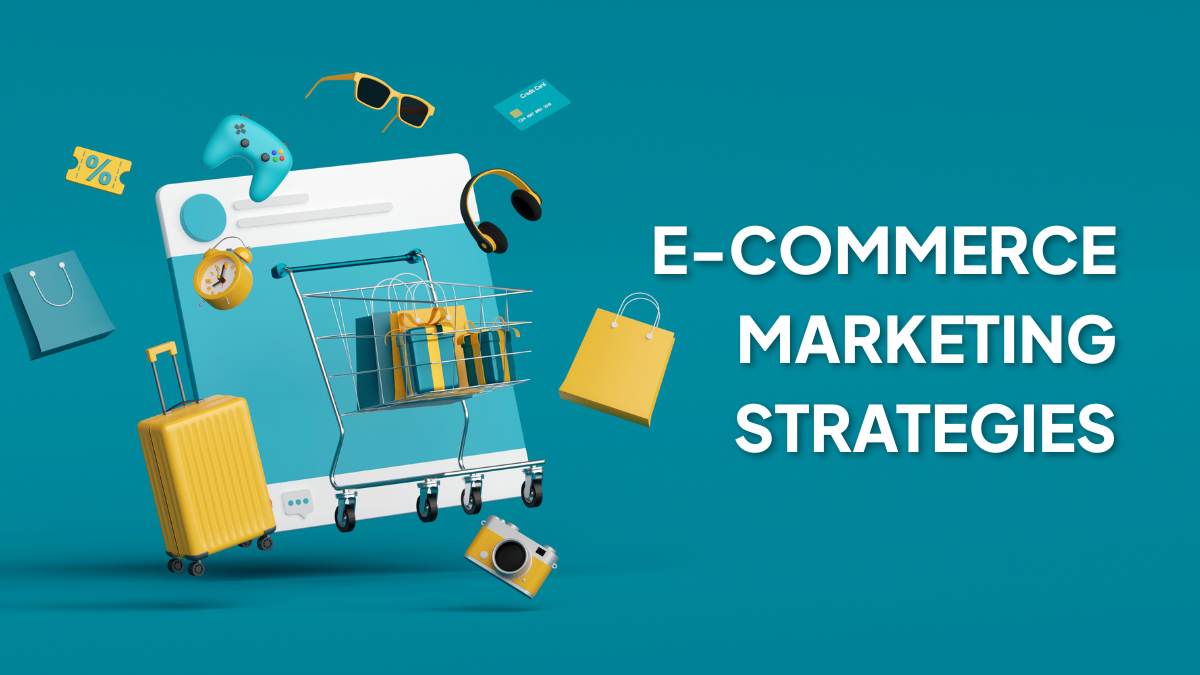Here’s the harsh truth no one tells you about e-commerce…
It’s not the best product that wins.
It’s not the lowest price that wins.
It’s the best marketer that wins.
You could sell socks with holes in them, and if your marketing’s sharp enough, people will still buy them. Meanwhile, someone with an amazing product but no real E-commerce Marketing Strategies? Crickets.
2025 is noisy. Everyone’s online. Ads cost more. Algorithms don’t care about your feelings.
But if you’ve got the right strategies backing you? You win.
Let’s break this down properly. No fluff. No shortcuts. Just stuff that works.
Let’s go deep.
Table of Contents
Why E-commerce Marketing is the Difference Between Growth and Stagnation
If you’re wondering why marketing deserves this much attention, here’s a quick stat to hit you with:
Most e-commerce stores don’t fail because of their product. They fail because not enough people know that the product exists, or the ones who do find the store bounce because something feels “off.”
Great marketing fixes that.
It brings people to your site. It helps them trust you. It gets them to pull out their card. And more importantly, it keeps them in your orbit.
What is E-commerce Marketing?
It’s not just about posting Instagram Reels or boosting a Facebook post.
It’s the full system:
- How you show up on Google
- What emails you send after someone buys (or doesn’t buy)
- How you retarget visitors with ads
- What influencers say about you
- What happens when someone opens your product at home
It’s all of it. It’s the ecosystem.
And if you do it right? Your store stops feeling like a one-off online shop and starts feeling like a brand. People love brands. People spend more with brands. You with me?
Also Read: Top E-Commerce Frameworks
Understanding E-commerce Marketing in 2025
Let’s break this down properly before we go into tactics, because the whole game is shifting – and honestly, a lot of people are stuck doing what worked 3 years ago.
Here’s where we’re actually at in 2025:
➔ It’s NOT Just Ads Anymore
I mean – ads are still important. Of course they are. Paid traffic’s how most people scale.
But if you’re only running ads and hoping for sales… you’re gonna bleed money.
2025 is all about systems.
Multiple touchpoints.
Everything talking to each other.
You want that beautiful moment where someone sees your TikTok, checks your site, leaves, sees your retargeting ad later on Instagram, clicks, reads your reviews, and then finally buys. Feels smooth, right? Feels intentional? That’s because it is.
➔ Multichannel vs Omnichannel vs Unified Commerce
Buzzwords? Yep. Important? 100%.
Let’s keep this simple:
- Multichannel = you’re on lots of platforms, but they don’t really “talk.”
- Omnichannel = better. Your channels connect. Abandon a cart → get an email → see an IG ad → buy.
- Unified Commerce = the final form. Your online store, your offline store (if you have one), your email, your social ads, your customer service – everything works off the same data. Like magic. It feels like one experience, not five disconnected ones.
Brands like Nike or Warby Parker are already doing this. Small brands? Totally possible with the right tools.
Also Read: How to create an Omnichannel Marketing Strategy
➔ Customer Journeys Matter More Than Single Campaigns
Look – having one flashy ad is fun. Launching a new product drop is exciting.
But people don’t shop based on just one moment anymore.
It’s the whole flow that matters.
- First touchpoint = curiosity.
- Second = research.
- Third = “hmm, maybe I’ll buy this weekend.”
- Fourth = “okay, that 10% off is tempting.”
- Fifth = “I’m in. Let’s go.”
Good e-commerce marketing? It guides people through that entire journey, smoothly.
Core Pillars of E-commerce Marketing
Okay, now we’re getting to the part that’s gonna make or break how you do marketing.
If these things aren’t solid, the strategies later in this blog won’t work half as well.
1. Product-Market Fit & Customer Understanding
Honestly, most brands don’t spend enough time here.
- Do you really know who your customer is?
- Have you read your competitors’ reviews to see what their customers love – or hate?
- Have you run a survey on your Instagram or sent an email asking why people love your products?
Without understanding your market deeply, you’re just throwing darts in the dark.
Real marketing starts with research.
2. Branding & Storytelling: Selling Experiences, Not Just Products
Why do people spend $80 on a hoodie from a random Instagram brand when they could get a decent one from H&M for half that?
It’s the story.
It’s the vibe.
It’s what wearing that hoodie says about them.
Branding is that invisible thread that makes someone say, “This is my brand.”
Are you talking about what your product does or what it means? Start leaning into the meaning.
3. Optimizing Product Pages
Please, please, stop sending traffic to product pages that look like they were made in a rush on a Sunday night.
- Make the product title clear.
- Use crisp, well-lit photos.
- Have persuasive copy. (Not just “high-quality material” – what does that do for the customer?)
- Add trust badges, customer reviews, and even short video clips if you can.
Think of your product page like the salesperson in a nice boutique. It needs to make people feel taken care of, not confused or rushed.
4. Personalization at Every Step
No one wants to feel like just another click.
If I bought running shoes from you last month, don’t send me promo emails for high heels (unless you know I was browsing those too).
Use what you know.
Be relevant.
And do it naturally – not creepy.
Proven E-commerce Marketing Strategies
(With a Shortcut If You Want It)
Let’s not overcomplicate this. We’re going to break down the real strategies you need to grow your e-commerce store. This isn’t theory – we’ve seen these work, we’ve used them ourselves, we’ve watched brands grow with these exact moves.
And hey – if you’re reading this thinking, “This is a lot… I wish someone just showed me exactly how to do all this” – then you should definitely check out Young Urban Project’s Digital Marketing Course.
We go deep into paid ads, content strategies, funnels, automations – the works. It’s like having someone sit next to you and say, “Okay, here’s exactly what you need to fix next.”
Anyway – back to work. Bookmark this.
1. Content Marketing for E-commerce
You want traffic that wants to buy? Write for people ready to buy.
→ SEO Blogs Targeting Purchase Intent
Think:
“Best watches for gifting under ₹5,000”
“Laptop bags for travel – what to look for”
People searching that are shopping, not just scrolling.
→ Product Guides & Comparisons
If you don’t explain why your product’s better, someone else will.
“Leather vs canvas bags: Which lasts longer?” – that kind of thing.
→ Gift Guides
Especially around festivals.
“Top 10 Rakhi gifts for your brother” – people Google this stuff, every year.
→ User-Generated Content (UGC)
Happy customers are better marketers than any ad you’ll pay for. Repost, celebrate, incentivize.
2. Email Marketing
Most brands ignore this or do it badly. That’s good news for you.
→ Cart Abandonment Sequences
Step 1: Reminder
Step 2: Social proof
Step 3: Discount or free shipping offer
→ Post-Purchase Flows
A “thank you” email isn’t optional. It’s expected.
Then cross-sell later with helpful suggestions – not spam.
→ Segmentation
Don’t send the same email to everyone. Your skincare customers don’t care about your shoe sale.
Also Read: Email Marketing Metrics
3. Paid Advertising
Ads are a tool, not magic. But when they work, they work.
→ Google Shopping & Performance Max
If you sell products, Google Shopping is a must. Clean up your product feed first.
→ Meta Ads (Facebook & Instagram)
Facebook ads and Instagram ads still great for warm audiences. Combine static images with videos. Test everything.
→ TikTok Ads
Tik Tok ads Massive potential for discovery, especially if you’re targeting younger crowds.
→ Retargeting
Don’t annoy people with 20 ads a day. 3-4 thoughtful, varied ads are plenty.
4. Social Media Marketing
Be human first, brand second.
Behind-the-scenes content wins. Show your process, your people, your packaging.
→ Social Commerce
Get Instagram Shopping live. TikTok Shop if you’re ready to play there. It’s all about one-click buying now.
→ Influencers
Micro > Macro for conversions. Build relationships, don’t just throw money at random creators.
Also Read: Build A Social Media Marketing Strategy in 7 Steps
5. Affiliate & Influencer Marketing
If you’re not running an affiliate program, start now. Even a Google Sheet works when you’re small.
Track sales properly.
For influencers, negotiate rights to reuse their content.
6. SEO for E-commerce
→ Optimize Your Product & Category Pages
Clear titles. Useful descriptions. Don’t stuff keywords – write for humans.
→ Rich Snippets & Schema
Make Google show your ratings, prices, stock status – free real estate in search results.
→ Internal Linking
Every blog should push people to a product.
Every product page should link to helpful guides. Cycle = revenue.
7. Conversion Rate Optimization (CRO)
Fix this before you dump money into ads.
→ Test One Thing at a Time
Don’t change five things and then wonder what helped.
→ Checkout Should Be Easy
Guest checkout. Apple Pay. Google Pay. No one wants to create another account unless they love you already.
→ Scarcity + Proof Works
“Almost sold out” and “3,200 sold this month” – both increase conversions. Use ‘em if they’re true.
8. Mobile-First Marketing
Most people are shopping from their phones now—it’s not even close. That’s why having a solid mobile marketing strategy isn’t optional anymore—it’s survival.
If your website’s clunky on mobile, or buttons are too small to tap with your thumb, you’re basically telling people to leave.
- Make buttons thumb-friendly.
- Speed matters. Compress those images.
- Don’t forget about mobile wallets—Apple Pay, Google Pay—they speed up checkout.
WhatsApp marketing? Brilliant if done right. Just… don’t spam people. If you annoy them, they’ll block you before you can say “limited-time offer.”
Your mobile marketing strategy should be about making buying ridiculously easy on the device they use most.
And again, if all this feels like a lot or you just want a shortcut to getting this dialed in properly, our Digital Marketing Course at Young Urban Project covers these exact systems with step-by-step help.

New Trends & Advanced Strategies
If you’re feeling ambitious:
- AI product recommendations → “People who bought this also loved…”
- AR/VR experiences → Try-ons for glasses, makeup, furniture.
- Subscriptions → Easy way to boost monthly recurring revenue.
- Voice Search → Optimize for “Hey Siri, reorder coffee filters”
- Sustainability & Brand Ethics → Modern buyers care about this. Show them what you’re doing, don’t just say it.
Metrics That Matter
If you’re not tracking these Marketing metrics, you’re flying blind:
- CAC (Cost per Customer)
- AOV (Average Order Value)
- LTV (Lifetime Value)
- Conversion Rate (Are visitors actually buying??)
Tools to use: Google Analytics 4 (GA4), Shopify Analytics, Meta Pixel, TikTok Pixel, and honestly – even spreadsheets.
Mistakes to Avoid
- Ignoring mobile optimization (we’ve covered this but it’s that serious)
- Not retargeting visitors (you worked hard to get them, don’t let them go)
- Relying only on paid traffic (SEO, email, organic social = cheaper long-term)
Conclusion
Look, e-commerce isn’t magic – it’s systems. It’s testing, tweaking, learning, and repeating. No single ad, tool, or hack will save a broken funnel. But when you combine smart strategies, a good product, and actual understanding of your customers? That’s when things click. 2025 is about experience, not shortcuts. Don’t just sell products – sell why those products matter. And stop thinking like a “store” – start acting like a brand. That’s where the long-term wins are.
FAQs: E-commerce Marketing Strategies
1. What are the most effective e-commerce marketing strategies for beginners?
Start with SEO blogs around your products, set up email cart-abandonment flows, and use simple retargeting ads. Don’t overcomplicate it – focus on building trust and making the buying process easier.
2. How is e-commerce marketing different from traditional marketing?
It’s faster, more measurable, and way more personal. You track clicks, sales, behavior, not just “brand awareness.” Traditional marketing’s like shouting in a crowd. E-commerce is like having a 1-on-1 chat.
3. Which is better: SEO or paid ads for e-commerce?
Both play different roles. SEO builds free traffic long-term. Paid ads give instant visibility. Use paid for sales boosts and SEO for steady growth over time.
4. How can I reduce cart abandonment rates?
Simplify checkout, show shipping costs early, add trust badges, and send reminder emails with incentives. Make buying feel safe and easy, not like a chore.
5. What’s the role of influencers in e-commerce marketing?
Influencers build trust. People listen to people they follow. Start with micro-influencers – they’re cheaper and more engaged. Test small first, then scale with the ones who convert.
6. How do I track the ROI of my e-commerce marketing campaigns?
Track your customer acquisition cost (CAC), average order value (AOV), and lifetime value (LTV). Use analytics tools like GA4 or Shopify. Compare spend vs. sales regularly to spot what’s working.

